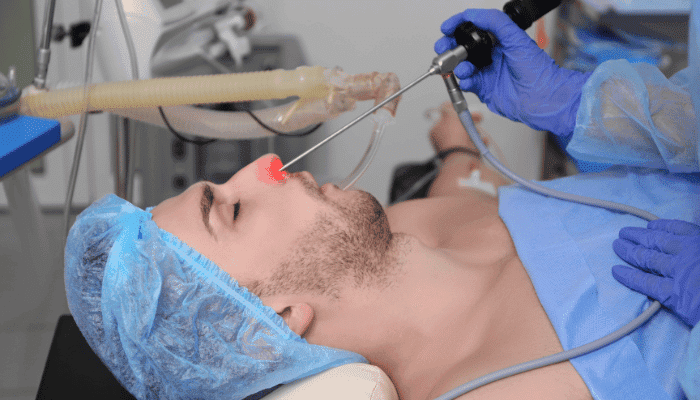The sinuses are hollow cavities located within the bones of the face, connected to the nasal passages. These structures play several roles, including moistening the air you breathe, producing mucus to trap particles, and contributing to vocal resonance. When complications arise within the sinuses, like blockages or inflammation, they can lead to discomfort and various medical conditions. Here’s information on sinus surgery and the sinus conditions that may require it:
What Are Some Sinus Conditions?
Sinus issues often develop when drainage pathways become blocked or inflamed. Such conditions interfere with normal functionality, causing irritation or chronic symptoms. For some individuals, sinus surgery becomes a viable option to enhance sinus function.
Polyps & Bacteria
Nasal polyps are noncancerous growths within the sinus lining. These often result from chronic inflammation and may block sinus passages, making airflow and mucus drainage difficult. This obstruction can create an environment favorable for bacterial infections, which may lead to recurring sinusitis. Sinusitis is a condition marked by persistent nasal congestion, pressure, and discharge. While medication can sometimes manage mild cases, larger polyps or recurrent bacterial infections often require surgical intervention to alleviate symptoms.
Damaged Structures & Scar Tissue
Structural abnormalities, like a deviated nasal septum, can also lead to sinus complications. A misaligned septum obstructs airways, contributing to sinus blockages. Prior infections, trauma, or even previous surgeries may cause additional scar tissue formation within the sinus passages. These blockages may not only limit nasal breathing but also reduce proper mucus drainage, leading to chronic infections. Sinus surgery may help repair these structural issues and restore functionality.
What Is Endoscopic Sinus Surgery?
Endoscopic sinus surgery is a minimally invasive procedure designed to address blockages within the sinuses. Using an endoscope, a thin tube equipped with a camera, surgeons can view the nasal passages in real-time on a monitor. Specialized instruments are then used to remove obstructions, including polyps, damaged tissue, or impacted mucus.
This approach allows for greater precision while sparing surrounding healthy tissues. Endoscopic procedures are performed entirely through the nostrils, reducing recovery times and minimizing visible scars. Endoscopic surgery is used to improve sinus drainage pathways while alleviating symptoms caused by chronic conditions.
What Is Surgery Like?
Before the procedure, patients typically undergo imaging, like a CT scan, to help identify problem areas. This preoperative planning assists surgeons in targeting specific obstructions. During the surgery, patients are often under general or local anesthesia, depending on the complexity of the procedure.
Recovery involves rest and avoiding activities that increase nasal pressure, such as heavy lifting or blowing the nose. Patients may need to use saline rinses to prevent buildup and encourage healing. Follow-up appointments allow surgeons to monitor progress and address any concerns.
The goal of sinus surgery is to:
- Clear Nasal Pathways
- Improve Sleep
- Reduce Facial Pain
- Prevent Infections
Learn More About Sinus Surgery
Sinus surgeries can offer relief for individuals struggling with chronic sinus conditions that do not respond to other treatments. By addressing underlying obstructions, surgery aims to restore proper sinus function and improve quality of life. Contact a qualified specialist to explore your options today.









